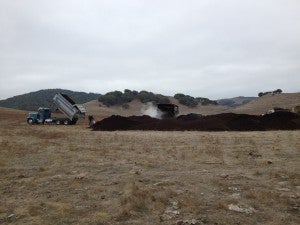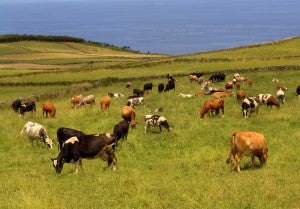Rangeland ecosystems cover approximately one third of the land area in the United States and half the land area of California. What if that vast domain could be utilized to combat climate change, and ranchers could get paid for land management practices that keep more carbon in the soil and enhance production?
That’s the direction we’re going, thanks to a new carbon accounting standard approved today by the American Carbon Registry. The new protocol allows ranchers who reduce their greenhouse gas footprint by applying compost to their fields to earn credits that can be traded on the voluntary carbon market.
Climate benefits
The standard is supported by research conducted by the Silver Lab at the University of California, Berkeley, which shows that applying a half inch of compost to rangeland soils removes greenhouse gases from the atmosphere at the rate of half a ton per acre each year.
If the practice of applying compost can be scaled to even 5 percent of California’s rangelands, we could capture approximately 28 million metric tons of carbon dioxide per year, which is about the same as the annual emissions from all the homes in California!
Compost can be created from any number of waste materials, including green waste (like lawn clippings) and municipal food waste. Using compost from food waste provides extra climate benefits.
According to the Environmental Protection Agency, food waste is the largest single waste stream going to landfills, totaling more than 36 million tons in 2012. When food is placed in landfills it generates methane, a greenhouse gas 20 times more potent than carbon dioxide. By diverting food waste from landfills and converting it into compost for rangelands, ranchers will help prevent the creation of new GHGs.
Proven benefits to ranchers

Compost on the range. Photo credit: Lynette K Niebrugge, Marin County Resource Conservation District
A handful of California land managers have pioneered the practice of applying compost to grasslands at two locations over the past seven years. These trials, part of the Marin Carbon Project, demonstrate that a one-time application of compost increases forage production 40-70 percent and doubles the water holding capacity of the soil—an increasingly important issue in drought-stricken California.
As an added value for ranchers, the practice may decrease the need to purchase feed because it improves forage quantity and quality.
The promising future of compost
These impressive results inspire us to expand compost research into additional geographies. While this new protocol can be implemented immediately on grasslands in Mediterranean climates, we are exploring the possibility of it bringing benefits to ranchers in different climate zones.
The potential to improve soil health and increase carbon sequestration on a variety of soil types and microclimates is exciting and could provide substantial benefits to ranchers. With the launch of this new protocol, EDF and its partners will continue to research, develop and promote ways that make it profitable for ranchers to stay on their land, enhance the health of rangelands and adapt to a climate changing world.











One Comment
Great to see this blog. Terra Global, who developed the protocol, looks forward to seeing this provide value to our rangeland partners!